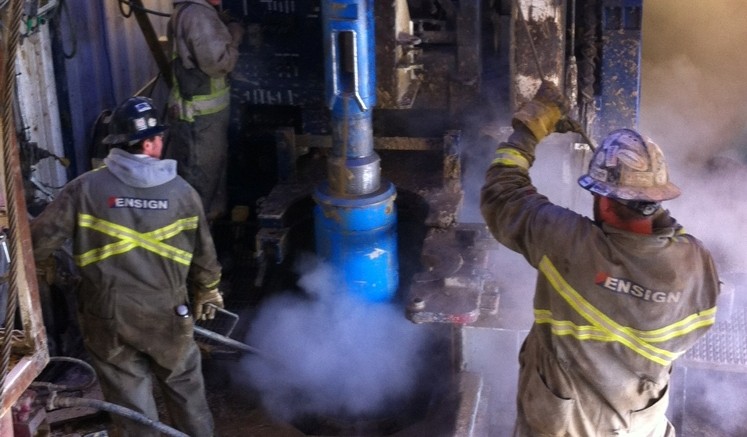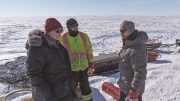Peregrine Diamonds (TSX: PGD) hopes to have its Chidliak project producing diamonds by 2021, as outlined in a preliminary economic assessment (PEA) released in July.
Chidliak sits 120 km northeast of Iqaluit, the capital of Nunavut, on Canada’s Baffin Island.
The study, which pegged capital costs at $435 million, projects Chidliak’s net present value at a pleasant $471-million, with an internal rate of return of 29.8% (after taxes and at a 7.5% discount rate). The operation would produce 1.2 million carats annually, with production peaking at 1.8 million carats per year.
According to the study, Chidliak could generate a 72% operating margin, with pre-tax average annual free cash flows of $131 million. The company’s five-year time line to production assumes feasibility-level scoping work next year, while permitting would conclude in time for development in mid-2019. The construction schedule would see the mine enter commissioning, and then production, in 2021.
Peregoodoff says that the project’s time line sets “realistic, but optimistic” goals.
“How the project develops this season will be very important, and if things go well you can certainly expect to see some major developments,” he adds.
“The PEA has the attention of the industry, so we’re now looking at all of our options, whether to raise the equity ourselves or potentially partner with other companies. There’s a lot going on in the Canadian diamonds scene right now, with Gahcho Kué opening last week and Renard potentially opening in October. There’s a lot of people out there that view Chidliak as a significant growth opportunity.”
Peregrine has uncovered 74 kimberlites on the property since 2008, but its startup operation would focus on what it calls the Southern Priority Area, due to better tonnage potential and coarse diamond distributions.
“It’s not very often you see such a high-margin, diamond-development project in Canada,” president and CEO Tom Peregoodoff tells Diamonds in Canada during a phone interview. “The economics are there to support an initial phase of mining, which gives us enough time and the cash flow to define and plan for the phase-two resource.”
Peregrine’s first phase of development would involve a decade-long open-pit diamond mine focused on resources from its CH-6 kimberlite before transitioning over to CH-7.
CH-7 hosts 5 million inferred tonnes of 0.85 carat per tonne for 4.23 million contained carats, while CH-6 hosts 4.6 million inferred tonnes grading 2.45 carats per tonne for 11.39 million contained carats.
Both resources extend to 250 metres depth, but Peregoodoff says there’s potential for underground development once the open-pit is exhausted.
“If the grade and stone value continues to depth, I think there is every possibility that you will see that deeper material come into the mine plan,” he says. “And we’re also looking at a number of pipes elsewhere on the property that we could move into a resource category.”
CH-1 in particular is an interesting pipe, Peregoodoff notes.
“The diamond colour profile there is fantastic and it has a good chance to contain high-quality stones. CH-31 and CH-33 are bigger pipes, which means they could have big tonnage potential, and our current information suggests they might have coarse, big diamonds,” he continues.
The development scenario outlined in the PEA comes with $435 million in development costs, which includes $95 million for a 160-km-long, all-weather road to Iqaluit. The alternative would be a seasonal road which could be open for six weeks or less during late winter, but Peregoodoff says that’s not enough time.
“We don’t have the same amount of water they have in the Lac de Gras region to utilize in the construction of an ice road. So for us, we’d be forced to fly in any supplies that you can’t bring in by the winter road. And that would put the operation in a big financial risk,” he says. “When we looked at all the risks and benefits of each scenario, we found that the all-weather road was the way to go. The cost wasn’t that much different and the impact on the economics wasn’t that material.”
Other diamond mines in Canada’s North, such as the Ekati and Diavik, are supported by winter roads, which operate eight to 10 weeks out of the year.
He adds that Peregrine may qualify for infrastructure funding from the federal government, or there could be some cost-sharing with other parties that may benefit from the road.
Over the next year, the company intends to advance the project’s resources from inferred into indicated with additional bulk samples and drilling, and continue with environmental-baseline work.
“Since 2009, we’ve completed 12 helicopter-supported surveys and one ground survey, and we’ve only seen 13 caribou,” he says. “So we’re not dealing with a caribou resource like a number of the larger herds you see elsewhere in Nunavut.”
The company’s shares have traded in a 52-week range of 9¢ to 31¢ per share, and closed at 23¢ at press time. Peregrine has 339 million shares outstanding for a $76.4-million market capitalization, and reported $5.7 million in working capital at press time. Robert and Eric Friedland hold 46% of Peregrine’s outstanding shares.
— Lesley Stokes is a staff writer with The Northern Miner in Vancouver; Matthew Keevil is The Northern Miner’s western editor.
This article was originally published in the November issue of Diamonds in Canada, with files from The Northern Miner.



Be the first to comment on "Peregrine eyes first production by 2021"